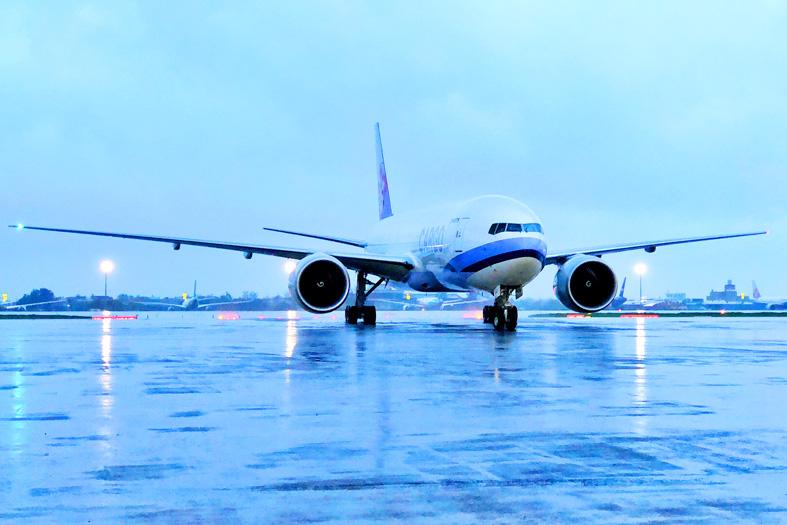China Airlines Ltd (CAL, 中華航空) yesterday reported passenger revenue of NT$912 million (US$30.51 million) for last month, an increase of 407 percent from a year earlier and the highest monthly figure over the past two years, as travel demand recovered amid eased border controls and the arrival of summer vacation.
On a monthly basis, passenger revenue was up 87 percent, CAL said.
“The growing passenger revenue proved that our increase in passenger flights from June was an effective strategy, and we will continue expanding our passenger services in the third quarter,” CAL said in a statement.

Photo: CNA
The number of its passenger flights would rise 40 percent in the third quarter from the second quarter, with the number of weekly flights raised to 150, CAL said.
From late next month, the airline would offer three flights from Taoyuan to London per week, and it would resume its service from Taoyuan to Bali, Indonesia, with two flights per week, beginning in September.
CAL’s cargo revenue grew at a slower pace last month, rising 22 percent year-on-year to NT$10.17 billion, but dropping 4 percent from a month earlier, as China’s COVID-19 lockdown measures affected air shipping, it said.
While freight demand in Europe, Japan and North America remained stable last month, shipping slowed in Asia as manufacturers were hit by a shortage of raw materials, CAL said.
Competition is also rising, as many airlines are boosting flights, affecting shipping rates, CAL said.
As air cargo is facing uncertainty because of high oil prices and inflation, CAL would prioritize high-end orders such as semiconductor equipment, electronic devices and automobile materials, it said.
In the first six months of this year, CAL’s passenger revenue grew 73 percent year-on-year to NT$3.27 billion, accounting for less than 5 percent of its total revenue, while cargo revenue grew 28 percent to NT$64 billion.
Overall revenue rose 30 percent from a year earlier to NT$74 billion in the six-month period, it said.
Meanwhile, CAL said that from Aug. 2, passengers on all of its international routes and those of its subsidiary Mandarin Airlines Ltd (華信航空) would be limited to two pieces of checked baggage.
Under the new system — which is already in use on CAL’s North American routes — economy-class passengers can check a maximum of two bags weighing up to 23kg each, with the per-bag limit set at 28 kg for premium economy ticket holders, and 32 kg for those in business class.
Despite capping the number of bags, the total weight allowance for passengers’ checked baggage would increase, it said.
Premium economy passengers, for example, will now be able to check in an extra 21kg compared with the previous 35kg total baggage limit, it added.
Separately, EVA Airways Corp (長榮航空) reported that its passenger revenue rose 36 percent annually to NT$1.17 billion last month, while its cargo revenue advanced 39 percent to NT$8.44 billion.
For the first half of this year, EVA’s cumulative revenue expanded 46 percent to NT$57 billion.
Additional reporting by CNA

Power supply and electronic components maker Delta Electronics Inc (台達電) yesterday said second-quarter revenue is expected to surpass the first quarter, which rose 30 percent year-on-year to NT$118.92 billion (US$3.71 billion). Revenue this quarter is likely to grow, as US clients have front-loaded orders ahead of US President Donald Trump’s planned tariffs on Taiwanese goods, Delta chairman Ping Cheng (鄭平) said at an earnings conference in Taipei, referring to the 90-day pause in tariff implementation Trump announced on April 9. While situations in the third and fourth quarters remain unclear, “We will not halt our long-term deployments and do not plan to

‘SHORT TERM’: The local currency would likely remain strong in the near term, driven by anticipated US trade pressure, capital inflows and expectations of a US Fed rate cut The US dollar is expected to fall below NT$30 in the near term, as traders anticipate increased pressure from Washington for Taiwan to allow the New Taiwan dollar to appreciate, Cathay United Bank (國泰世華銀行) chief economist Lin Chi-chao (林啟超) said. Following a sharp drop in the greenback against the NT dollar on Friday, Lin told the Central News Agency that the local currency is likely to remain strong in the short term, driven in part by market psychology surrounding anticipated US policy pressure. On Friday, the US dollar fell NT$0.953, or 3.07 percent, closing at NT$31.064 — its lowest level since Jan.

The US dollar was trading at NT$29.7 at 10am today on the Taipei Foreign Exchange, as the New Taiwan dollar gained NT$1.364 from the previous close last week. The NT dollar continued to rise today, after surging 3.07 percent on Friday. After opening at NT$30.91, the NT dollar gained more than NT$1 in just 15 minutes, briefly passing the NT$30 mark. Before the US Department of the Treasury's semi-annual currency report came out, expectations that the NT dollar would keep rising were already building. The NT dollar on Friday closed at NT$31.064, up by NT$0.953 — a 3.07 percent single-day gain. Today,

The New Taiwan dollar and Taiwanese stocks surged on signs that trade tensions between the world’s top two economies might start easing and as US tech earnings boosted the outlook of the nation’s semiconductor exports. The NT dollar strengthened as much as 3.8 percent versus the US dollar to 30.815, the biggest intraday gain since January 2011, closing at NT$31.064. The benchmark TAIEX jumped 2.73 percent to outperform the region’s equity gauges. Outlook for global trade improved after China said it is assessing possible trade talks with the US, providing a boost for the nation’s currency and shares. As the NT dollar